DFI LANParty UT ICFX3200-T2R: ATI's, err, AMD's RD600 finally arrives
by Gary Key on December 16, 2006 7:00 PM EST- Posted in
- Motherboards
Standard Gaming Performance
As usual, gaming performance was tested with a variety of current games. We ran benchmarks with our standard 1280x1024 resolution without antialiasing enabled (and generally without anisotropic filtering, though that varies by game). Given the number of users that run 19 inch LCDs these days, 1280x1024 represents one of the most commonly used resolutions. We could certainly increase the amount of eye candy being displayed in most of the games, but as this is a motherboard benchmark we aren't particularly interested in maxing out the graphics cards for all tests.
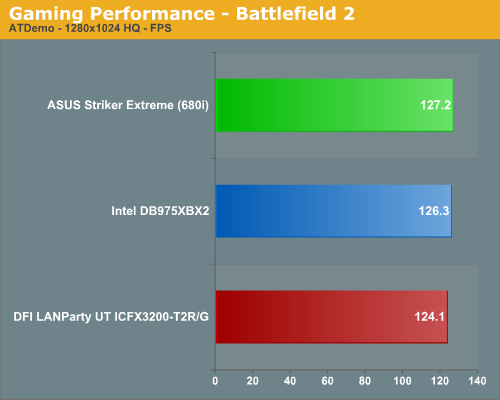
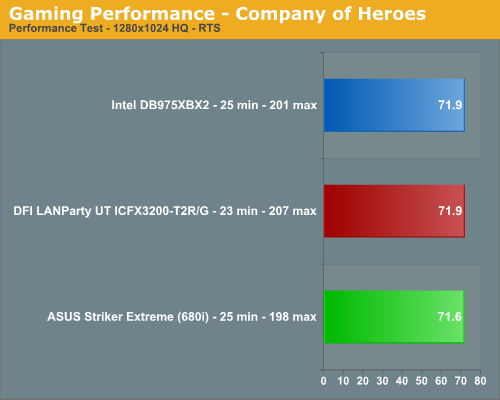
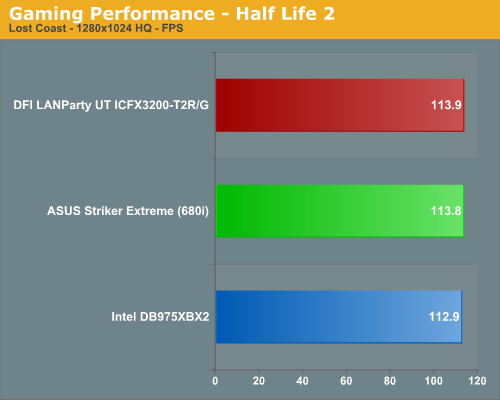
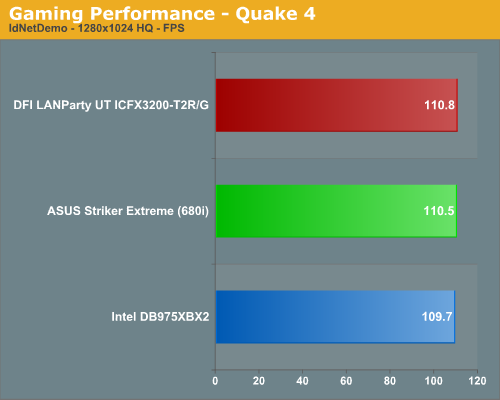
As we commented previously, gaming benchmarks seemed to favor the RD600 although our Battlefield 2 scores are puzzling considering the almost three percent drop in performance at these settings. Battlefield 2 at this time is fairly sensitive to CPU speed and memory timing improvements which did occur as we changed either our CPU speed or optimized our memory settings, but the board never caught the 975X or 680i at the same settings. However, very few people would ever notice a difference between the various motherboards while gaming although Quake 4 seemed more fluid on the DFI board during online game play across our LAN. We will be testing the DFI board with the GeForce 8800GTX to see how well it performs but at this time most games seem to favor the RD600 while Battlefield 2 does not, at least in single card testing.
High-Resolution Gaming Performance
For high-quality gaming performance, we also tested at 1600x1200 with 4xAA/8xAF. As just about anyone familiar with current games can tell you, benchmarking with a single high-end graphics card at those stressful settings will make almost any recent game GPU limited. In fact, several of the most recently released games such as Oblivion can be GPU limited at this setting even with CrossFire or SLI setups. Our test results are limited to two games for now, but we will provide expanded coverage in our next article, including Intel P965 and 1920x1200 results.
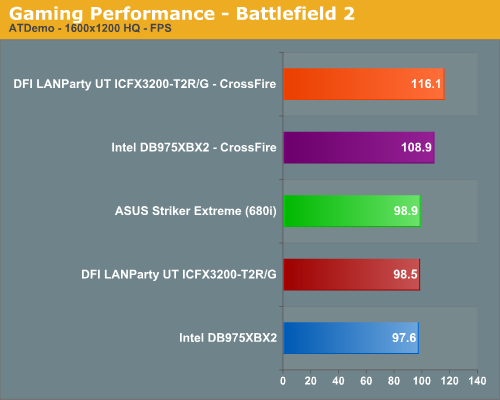
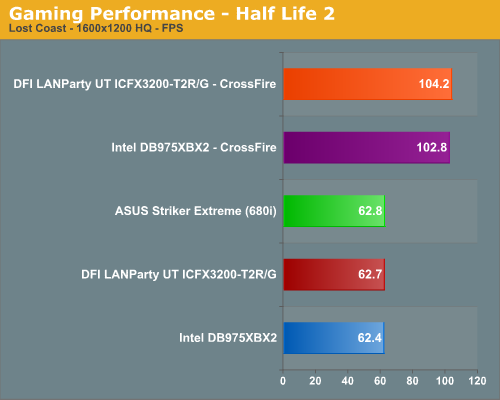
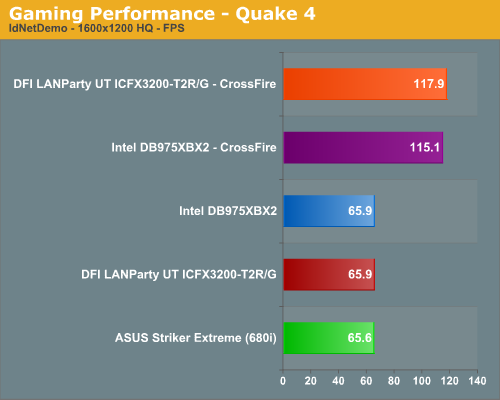
If you're serious about gaming at higher resolutions with all the eye candy enabled, you will most certainly want to run a multi-GPU configuration. Looking specifically at the DFI board, its relative positioning has improved greatly when playing Battlefield 2 under CrossFire along with improvements in Half Life 2: Lost Coast. It appears the optimizations that ATI built into their chipsets for CrossFire performance are indeed noticeable at the higher resolutions. Our 1280x1024 CrossFire testing yielded very few differences but the performance gap between the 975X and RD600 widened as we increased our resolution and AA/AF settings. We also noticed this same behavior in other games that we tested including Company of Heroes and F.E.A.R.
The only issue with X1950 CrossFire now is that NVIDIA's 8800 GTS/GTX cards can provide substantially higher performance, particularly in SLI configurations. As usual, SLI is not officially supported by NVIDIA on non-NVIDIA chipsets, and likewise you can't run CrossFire on NVIDIA chipsets. That means that 8800 GTX SLI and a 680i board would currently be a faster gaming solution, but AMD will counter with R600 early next year. Whether or not they can reclaim the performance crown remains to be seen, so if you're not in any hurry to spend a lot of money on upgrading it might be best to wait and see what happens.
As usual, gaming performance was tested with a variety of current games. We ran benchmarks with our standard 1280x1024 resolution without antialiasing enabled (and generally without anisotropic filtering, though that varies by game). Given the number of users that run 19 inch LCDs these days, 1280x1024 represents one of the most commonly used resolutions. We could certainly increase the amount of eye candy being displayed in most of the games, but as this is a motherboard benchmark we aren't particularly interested in maxing out the graphics cards for all tests.




As we commented previously, gaming benchmarks seemed to favor the RD600 although our Battlefield 2 scores are puzzling considering the almost three percent drop in performance at these settings. Battlefield 2 at this time is fairly sensitive to CPU speed and memory timing improvements which did occur as we changed either our CPU speed or optimized our memory settings, but the board never caught the 975X or 680i at the same settings. However, very few people would ever notice a difference between the various motherboards while gaming although Quake 4 seemed more fluid on the DFI board during online game play across our LAN. We will be testing the DFI board with the GeForce 8800GTX to see how well it performs but at this time most games seem to favor the RD600 while Battlefield 2 does not, at least in single card testing.
High-Resolution Gaming Performance
For high-quality gaming performance, we also tested at 1600x1200 with 4xAA/8xAF. As just about anyone familiar with current games can tell you, benchmarking with a single high-end graphics card at those stressful settings will make almost any recent game GPU limited. In fact, several of the most recently released games such as Oblivion can be GPU limited at this setting even with CrossFire or SLI setups. Our test results are limited to two games for now, but we will provide expanded coverage in our next article, including Intel P965 and 1920x1200 results.



If you're serious about gaming at higher resolutions with all the eye candy enabled, you will most certainly want to run a multi-GPU configuration. Looking specifically at the DFI board, its relative positioning has improved greatly when playing Battlefield 2 under CrossFire along with improvements in Half Life 2: Lost Coast. It appears the optimizations that ATI built into their chipsets for CrossFire performance are indeed noticeable at the higher resolutions. Our 1280x1024 CrossFire testing yielded very few differences but the performance gap between the 975X and RD600 widened as we increased our resolution and AA/AF settings. We also noticed this same behavior in other games that we tested including Company of Heroes and F.E.A.R.
The only issue with X1950 CrossFire now is that NVIDIA's 8800 GTS/GTX cards can provide substantially higher performance, particularly in SLI configurations. As usual, SLI is not officially supported by NVIDIA on non-NVIDIA chipsets, and likewise you can't run CrossFire on NVIDIA chipsets. That means that 8800 GTX SLI and a 680i board would currently be a faster gaming solution, but AMD will counter with R600 early next year. Whether or not they can reclaim the performance crown remains to be seen, so if you're not in any hurry to spend a lot of money on upgrading it might be best to wait and see what happens.










42 Comments
View All Comments
baronzemo78 - Monday, December 18, 2006 - link
I would like to thank Gary for all the hard work getting this preview out so fast. I am still very excited about this board. I'm waiting for the R600 anyway, so hopefully by then the stability and BIOS options of the board will have improved. I'm very curious to see if the R600 in crossfire will need more then the x8 pcie bandwith. I certainly hope it doesn't as an overclocked RD600 with a R600 sounds awesome to me. Anyway thanks again for the preview and keep up the good work.Lord Evermore - Sunday, December 17, 2006 - link
First page says SB600 offers multiple LAN ports, but SB600 has no LAN support, and the Marvell controllers are off the PCIe links from the northbridge.It seems odd that ATI didn't design the SB600 with at least a couple of extra PCIe lanes. Right off the bat, this mainboard has zero upgradeability for PCIe devices, if you set up the intended dual graphics and physics cards. No hot new PCIe sound cards, TV tuners, SCSI cards.
SB600 automatically becomes a nice competitor to Intel's chipsets, due to the included PATA support, so there's no need for an add in PCI IDE controller. ATI/AMD's overview page though is a bit misleading, as they claim the built-in SATA controllers support "all RAID levels".
You're blaming DFI's board layout for large heatsinks not fitting into smaller cases? They had to put the socket somewhere, if that's the issue, and no matter where board makers put things, reviewers ALWAYS seem to find some complaint because of odd components not fitting or cabling not being perfect. And you didn't even mention those 90 degree angled SATA ports. I haven't seen that before. Might those not be an issue if you don't use a cable with a clip, since the downward pull of the cables is now going longways instead of across the width of the connector? (Same thing could apply to any SATA or IDE ports aligned perpendicular to the expansion slots really, but most boards don't have them that way that I've seen, possibly for that very reason.) Yeah I know, it might get mentioned in a more in-depth review, but that stands out more to me than 0.1% of the available heatsinks not fitting in a tiny case.
Why would the third PCIe slot need to be "jumpered for PCI Express card operation"?
That Promise RAID looks like crap. The single drive SB600 performance almost beats it. Why no benchmarks with the SB600 RAID, or the Intel or Nvidia RAID? It would be nice to know if ATI can beat the roughly 50% performance gain of the others.
Too bad this might be the only board ever made with this chipset, and that there won't be a more value-oriented line. I can do without the CrossFire support or the physics slot (although having the option of a non-graphics x8 or x2 slot with x16 physical support would be nice), and I can do with a reduction in the amount of tweaking options, or the add-in Promise controller, or dual LAN and the better audio solution. And the color scheme could be done without. I'm tempted by Core2Duo chips, but none of the other chipsets or boards really looks that great to me in terms of features.
Gary Key - Tuesday, December 19, 2006 - link
With the latest beta BIOS release -If you disable Promise and SB600 RAID you can use the second X16 slot (x8 electrical) for a RAID card, it will switch your first x16 slot from x16 to x8 operation.
The physics slot (x2 electrical) works fine with our x1 Network or TV Tuner cards once you switch the jumper now. This is required to change the operation of the slot based upon the switching mechanism employed with the future Physics setup.
I am not blaming DFI for large heatsinks not fitting in smaller cases. I was just pointing out the fact that it could be an issue for those that try it. I like the open space myself due to the offset but that creates another issue for some users. It is just information being provided.
The SB600 can support LAN depending upon how they configure it. DFI that it would be best for dual Lan coming off the RD600 instead.
The other RAID benchmarks are coming in our follow-up as stated in the article.
The 90 degree angled SATA ports are being used in most of the new board designs now. Look at most of the 680i boards and you will find they are being used extensively now. We did not have any issues with the cables slipping out.
yyrkoon - Monday, December 18, 2006 - link
Thats why "we" just review the product, and not send them off to some salt mines, somewhere ;) This is after all, a review, everyone has an opinion, and if it doesn't bother you, simply disregard, and use common sense . . .
Sh0ckwave - Sunday, December 17, 2006 - link
Looks like a decentn my cramped case. board. I just need to know if my Infinity will fit on it icornfedone - Sunday, December 17, 2006 - link
From this initial review this mobo sure sounds temperamental and a shaky design if you see dramatic changes with BIOS settings and instability sometimes. The fact that it's performance changes radically with memory or CPU changes is not an indication of a stable mobo design.More BIOS adjustments does not necessarily make for a better mobo design if all the options do is make the mobo unstable or crash. This is a typical case of more is not better. The extra options are used as a rationale to jack the price and increase profits from consumers who lack the technical expertise to understand the motivation for such useless BIOS options.
As far as the ATI/AMD labels go, I don't know why many in the online enthusiasts PC hardware segment make such a big deal out of AMD renaming the ATI products with AMD labels. Every company I know of that has bought another company, renames the products, so this ain't no big deal. If you don't like the product don't buy it. The name of the product has no impact on how it performs.
mino - Tuesday, December 19, 2006 - link
Also on the maning "issue".Most sites "big deal out of AMD renaming the ATI products" not because ot the renaming - no problem there.
The thing is, one of the best chipsets/if not THE best for Intel comming form AMD, well, that IS something.
Also remember, AMD chipset ? That has not been in the consumer market for LONG time. At the same note, most average people have no idea that X200=X3200IE=RD600 and is from the RD480line... to those (aned there are many of them!) this is a big deal as they do not have to dig the info themselves.
Also, at least to me, seeing it makes me smile usually...
mino - Tuesday, December 19, 2006 - link
maning==namingmino - Tuesday, December 19, 2006 - link
Well, at first You should understand what "temperamental when messing with BIOS" and temaperamental at "stock" means.When the board is "temperamental" when messing with BIOS, ti means YOU are messing with something you have no idea what it is or what it does!
If you do not understand what overclocking really means, do NOT overclock at all.
Overclocking is about running things "one the edge" ... and to find that "edge" you NEED to be able to push the board over it.
To be able to do so is a dream of an overclocker as it enables him to get most performance from any set of components.
I love those dumbass "overclockers" who assemble a mid-range machine, install some ClockGen-like utility, overclock it until it becomes unstable and consider themselves "overclockers".
To topic:
!!! I LOVE THE IDEA OF THOSE UNDERVOLTING OPTIONS !!!
More boards should offer those, it is far more usefull and safe than overvolt jet most boards do not offer it... ;-(
mino - Tuesday, December 19, 2006 - link
sry for the typpos :)